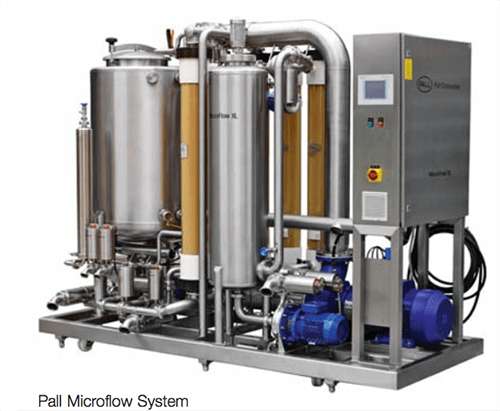Pall® Microflow Brine system offers 10 months payback in cheese brine purification
Overview
Salting by immersion in brine is used for many varieties of cheese worldwide. During repeated immersions fat, curd particles and microorganisms from the cheese plus the accumulation of proteins and other components builds up a nutrient-rich environment for the salt resistant microorganisms. Reused brine may then become a reservoir of unwanted microorganisms, such as gas- or pigmentproducing bacteria, yeast and mold, or salt resistant pathogens, cross-contaminating the cheese and impacting their quality. Good control of the brine and the brining operation is essential to ensure consistent daily production. Additionally, brine disposal is coming under increasing focus. High disposal costs or volume limitations in specific areas are driving the demand for greater brine reuse, to generate operating cost savings and minimize the plant environmental footprint.
The Challenge
A reputable cooperative producing DOP (Designated Origin of Production) hard cheese of Grana type in Northern Italy wanted to optimize the quality of the brine at various plants and reduce its overall costs for waste stream disposal. Owned by 30 small producers, the cooperative was looking for a user-friendly, simple technology to be installed in a truck for regular operation at each of the cheese plants. Brine had a typical turbidity of >100 NTU.
Microfiltration, at regular intervals of 3 to 6 months depending on the dairy, was selected to reduce the cheese cross-contamination risk and to provide high brine clarity, both influencing the cheese quality. With the high local disposal fee for salty effluent, it was clear that brine microfiltration would lead to significant benefits. The length of the brine salting process is 20 days on average, in pools ranging from 20 to 200 m3 (5,283 to 52,835 USgal), and throughput of 2 m3/h (528 USgal/h). Other important requirements included the ability to handle high contaminant load and variation from batch to batch, optimized water and chemical consumption during cleaning cycles, and user-friendly operation with reduced labor and downtime.
The Solution
Pall Microflow Brine Microfiltration Systems Pall Microflow Brine microfiltration technology provides constant and high filtrate brine quality and a reliable environmentally-friendly solution to extend the life of brine and prevent cheese quality downgrades. Typical performance of the Microflow system is a filtrate turbidity below 0.8 NTU, combined with high microbial reduction efficiency, typically up to a log reduction value (LRV) >5 in operation in the cheese plant, and up to LRV >10 when challenge tested with Listeria by an external laboratory.
The system consists of robust Polyvinylidene Fluoride (PVDF) hollow fibers with high mechanical strength and excellent chemical resistance, capable of high flux rates, within in a compact system footprint. When operated with an optimized combination of hot water and chemical cleaning sequences, reductions of up to 50 % in water usage and 30 % in cleaning time and chemicals have been demonstrated, compared to other membrane systems. Pall® Microflow Brine system offers 10 months payback in cheese brine purification Application Bulletin Pall Microflow System Key features of the Pall Microflow Brine system include:
- PVDF membranes with high mechanical strength for longer service life
- Backflush capability of the Microza* hollow fiber membrane, maintaining a higher flux over a longer operating cycle
- Hollow fiber membrane with a 1.4 mm open channel for optimized cleaning
- On board cleaning / waste concentration tanks
- Automated chemical dosing for operator safety
- Water filtration, cleaning temperature control
- All product-wetted components in 316L stainless steel
- Fully automated cycle programming for unattended operation
Additional equipment, including a hot water production unit, a chiller and a coarse bag filter to remove large particles and fines, completed the installation on the truck for efficient and autonomous operation. The Microflow Brine technology platform addressed the need for reliable and cost-effective brine regeneration – a solution that eliminates the use of traditional solutions such as DE pre-coat filters or heat exchangers.
The Benefits
The Pall Microflow Brine microfiltration system enables dairies to perform clarification at low operating costs while providing constant and high brine filtrate quality, thus improving the cheese manufacturer’s economics. Combining the unique features of the Microflow microfiltration platform with Pall’s professional service support in optimizing operating parameters, translated into significant benefits for the customer.
- Less than 1 year ROI
- Minimized waste disposal costs due to extended brine life and high brine recovery from the system, with less then 1 % discharge
- More consistent cheese quality due to high brine quality
- Minimized water and cleaning chemical consumption due to a unique cleaning sequence and a simple sanitary system design with no dead legs
- Reduced labor and downtime due to fully automated cycle programming
- Reduced maintenance costs provided by high system reliability and proven operation
- Simple monitoring of module integrity
About Pall Corporation
Pall Corporation is the largest and most diverse filtration, separation, and purification company in the world. Pall serves the food and beverage industries with advanced membrane filtration technology and systems engineered for reliability and cost-effectiveness. Easy to install and simple to use, our systems satisfy a wide range of filtration requirements. Our Total Fluid Management approach offers customers solutions to address the needs of an entire process, encompassing filtration products, services, systems and training.




